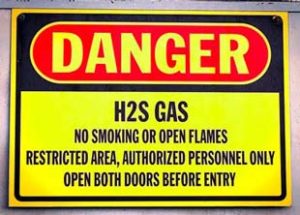Hydrogen Sulfide (H2S) Hazard Awareness Training
Home Online OSHA Training Courses Hydrogen Sulfide (H2S) Hazard Awareness Training
H2S Certification – Initial & Annual Refresher Training for Workers
OSHA and ANSI both recommend all workers in areas where there is a high potential for unsafe levels of Hydrogen Sulfide (H2S) gas receive initial training on H2S hazard identification and control methods. The online Hydrogen Sulfide Certification courses for H2S Awareness and the Annual H2S Refresher training course below help employers and employees comply with these recommendations.
Workplaces where there is a reasonable potential for high levels of hydrogen sulfide (H2S) gas include, but are not limited to, the following operations:
- Chemical plants
- Mining operations
- Oil and gas drilling operations
- Oil and gas refineries
- Rayon manufacturing operations
- Tanning factories
- Wood pulp and paper processing plants
The H2S training must be provided to all workers upon assignment to jobs / tasks with a reasonably high exposure to Hydrogen Sulfide (H2S). Refresher training on H2S safety must be repeated annually for all affected employees.
Online Hydrogen Sulfide (H2S) Certification Courses

Hydrogen Sulfide (H2S) Awareness Training Course
Only $39
Alternatively, Click Here to purchase multiple courses to assign to your workers

Hydrogen Sulfide (H2S) Annual Refresher Training Course
Only $34
Alternatively, Click Here to purchase multiple courses to assign to your workers
Important H2S Training Certification Course Information
These Hydrogen Sulfide (H2S) certification training courses are intended to help provide affected personnel with basic general knowledge to help protect themselves from unsafe levels of hydrogen sulfide exposures. Topics addressed include, but are not limited to, the following:
- Common characteristics, sources and associated health and safety hazards of hydrogen sulfide (H2S).
- Signs and symptoms of hydrogen sulfide (H2S) exposure.
- Types of hydrogen sulfide (H2S) detection methods, and applicable H2S permissible exposure limits (PELs).
- General work practices and procedures to protect against hydrogen sulfide (H2S) exposure.
- Importance of knowing worksite-specific emergency action plans, locations of safety equipment, rescue techniques, and first-aid.
Hydrogen Sulfide Safety: A Comprehensive Overview
Understanding Hydrogen Sulfide (H₂S)
Hydrogen sulfide (H₂S) is a colorless gas with a distinctive odor of rotten eggs at low concentrations. It is known for being highly toxic and flammable, posing significant health hazards to workers if not properly managed. This guide will cover the dangers of H₂S, its characteristics, where it can be found, OSHA permissible exposure limits (PELs), API standards, and required training to ensure safety in the workplace.
Dangers of Hydrogen Sulfide (H₂S)
Hydrogen sulfide is a potent respiratory toxicant and poses various health risks depending on the concentration and duration of exposure:
- Low Concentrations (0.0005 to 10 ppm): Can cause irritation of the eyes, nose, throat, and respiratory system, as well as headaches, dizziness, and nausea.
- Moderate Concentrations (10 to 50 ppm): May lead to more severe symptoms such as coughing, vomiting, difficulty breathing, and eye irritation.
- High Concentrations (50 to 100 ppm and above): Exposure can result in serious health effects including shock, convulsions, inability to breathe, extremely rapid unconsciousness, coma, and potentially death.
- Very High Concentrations (500 ppm and above): Immediate loss of consciousness and death within minutes.
Understanding these dangers underscores the importance of effective H₂S safety measures in workplaces where the gas is present.
Characteristics of Hydrogen Sulfide (H₂S)
- Chemical Formula: H₂S
- Molecular Weight: 34.08 g/mol
- Boiling Point: -60.33°C (-76.59°F)
- Density: Heavier than air, allowing it to accumulate in low-lying areas.
- Flammability: Highly flammable, can form explosive mixtures with air.
- Odor: Characteristic smell of rotten eggs, detectable at very low concentrations (0.0005 to 0.3 ppm), though olfactory fatigue can occur, making it hard to detect after initial exposure.
Where H₂S Can Be Found
Hydrogen sulfide is commonly found in various industrial and natural settings, including:
- Oil and Gas Industry: Natural gas, petroleum extraction, and processing.
- Sewage Treatment Plants: Produced during the decomposition of organic matter.
- Agricultural Operations: Manure pits and decomposition of animal waste.
- Pulp and Paper Mills: Generated during the pulping process.
- Volcanic Eruptions and Geothermal Activities: Naturally occurring sources.
OSHA Permissible Exposure Limits (PELs) for H₂S
To protect workers from the hazards of H₂S, the Occupational Safety and Health Administration (OSHA) has established the following Federal permissible exposure limits:
- Permissible Exposure Limit (PEL): 20 ppm (parts per million) as a ceiling limit, meaning this concentration should not be exceeded at any time during the workday.
- Acceptable Maximum Peak Above the Ceiling Concentration for an 8-hour Shift: 50 ppm for 10 minutes, provided no other measurable exposure occurs during the shift.
Employers must adhere to these limits and implement appropriate measures to monitor and control H₂S exposure in the workplace.
API Standards for H₂S
The American Petroleum Institute (API) has developed standards to manage H₂S hazards in the oil and gas industry, including:
- API RP 55: Recommended Practice for Conducting Oil and Gas Producing and Gas Processing Plant Operations Involving Hydrogen Sulfide. This document provides guidelines for the safe handling and control of H₂S, including engineering controls, monitoring, and emergency response procedures.
- API RP 49: Recommended Practice for Drilling and Well Servicing Operations Involving Hydrogen Sulfide. This standard focuses on safe drilling and well-servicing operations, including the use of personal protective equipment (PPE), detection systems, and training requirements.
OSHA and API Training Requirements
Effective training is crucial to ensure workers are aware of H₂S hazards and know how to protect themselves. Both OSHA and API have specific training requirements:
OSHA Training Requirements
- Hazard Communication (HAZCOM): Employers must inform and train workers about the presence of H₂S and its hazards, including proper labeling, safety data sheets (SDS), and appropriate protective measures.
- Respiratory Protection Training: Workers must be trained on the proper use, maintenance, and limitations of respirators when required to protect against H₂S exposure.
- Emergency Response Training: Employers must provide training on emergency procedures, including evacuation plans, first aid, and medical response for H₂S incidents.
API Training Requirements
- H₂S Awareness Training: Workers in the oil and gas industry must receive training on the properties, hazards, detection, and control measures for H₂S. This includes recognizing the symptoms of exposure and knowing the appropriate emergency response actions. An annual refresher training certification is also required.
- Specialized Training for High-Risk Roles: Employees in roles with a higher risk of H₂S exposure, such as drilling or maintenance, require more comprehensive training, including hands-on practice with detection equipment and PPE.
Detection and Monitoring of H₂S
Accurate detection and continuous monitoring of H₂S levels are essential for workplace safety:
- Fixed Gas Detectors: Installed in high-risk areas to provide constant monitoring and alert systems.
- Portable Gas Detectors: Used by workers to measure H₂S levels in real-time during operations.
- Personal Monitors: Worn by workers to detect H₂S exposure and alert them to evacuate or take necessary precautions.
Engineering Controls and Work Practices
Implementing engineering controls and safe work practices can significantly reduce the risk of H₂S exposure:
- Ventilation Systems: Proper ventilation helps disperse H₂S and maintain safe air quality levels.
- Enclosure and Isolation: Enclosing or isolating H₂S-generating processes can minimize exposure.
- Maintenance of Equipment: Regular maintenance and inspection of equipment can prevent leaks and accidental releases.
- Safe Work Procedures: Establishing and following standard operating procedures (SOPs) for tasks involving H₂S.
Personal Protective Equipment (PPE)
When engineering controls and work practices are not sufficient to mitigate H₂S risks, PPE is essential:
- Respiratory Protection: Use of air-purifying respirators (APR) or supplied-air respirators (SAR) depending on H₂S concentrations.
- Eye Protection: Safety goggles or face shields to protect against splashes or exposure to high concentrations.
- Protective Clothing: Impermeable clothing, gloves, and boots to prevent skin contact.
Emergency Response and Training
Effective emergency response planning and training are critical for handling H₂S incidents:
- Emergency Action Plans (EAP): Develop and implement EAPs that include evacuation routes, emergency contacts, and procedures for H₂S exposure incidents.
- Training Programs: Regular training for employees on H₂S hazards, detection, use of PPE, and emergency response procedures.
- First Aid and Medical Response: Ensure availability of first aid kits and trained personnel to provide immediate medical assistance.
Conclusion
Hydrogen sulfide poses a significant risk to workers in various industries. Understanding its properties, adhering to OSHA regulations, implementing effective detection and monitoring systems, utilizing engineering controls, providing appropriate PPE, and preparing for emergencies are essential steps in ensuring H₂S safety. Continuous education, training, and improvement of safety protocols are crucial to protect workers from the dangers of hydrogen sulfide exposure.
